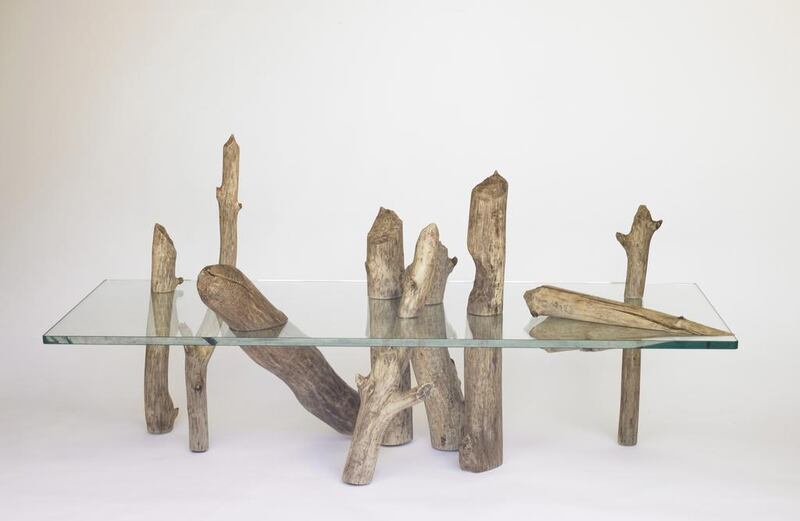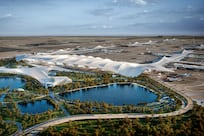When Yuill McGregor sees a beautiful piece of wood, he wants to touch it — and he doesn't think that he's alone in this. As the founder of the Canada-based North on Sixty, which specialises in the design and build of timber products and interiors, McGregor has been playing around with wood for more than 40 years, but still gets a kick out of the look and feel of it.
“Wood is alluring in a way that no other material is, and it crosses all boundaries,” says McGregor. “Whether it be in the Arab world or Asia, it doesn’t matter; everybody responds to wood in much the same way. What they have to do is touch it.”
Materials such as steel, marble, aluminium or glass might work together to create some very dramatic-looking buildings, but when placed side-by-side with beautiful pieces of wood, people will always be naturally drawn to the timber, McGregor suggests.
“If I ask you to pick a material that you want to feel, the one that you want to touch, I’ll bet eight out of 10 will choose the beautiful wood. People cannot stop themselves from doing it.”
McGregor is due to speak at The Designer’s Forum, part of the Middle East Covering and the Middle East Stone Show, which takes place from May 23 to 26 at the Dubai World Trade Centre.
Although the use of wood in interiors is less common in the Middle East than his native Canada, McGregor has seen first-hand how it can draw people in, and hopes to use that allure to promote the material further in the region.
“I was at the Index exhibition in Dubai, and a group of eight young women from a design school in Oman were standing around my old-growth yellow birch figured table, touching it and asking great questions about its finish,” he says. “I was surprised not just by the fact that they were drawn to it, but about how much of a connection they had to it. I’m half way across the world, and everybody’s talking about wood in the same way we do in North America.”
This passion for what timber has to offer is one of the reasons that McGregor thinks his more bespoke offerings in furniture and flooring can have a significant impact here. With designers in the region hailing from all over the world, he’s confident, too, that they are ready and willing to specify timber, if they can be sure of getting signature pieces that make a mark. But bringing the warmth and beauty that timber can offer a design isn’t achieved through mass-market tactics.
“I’m always a guy working in niche markets,” says McGregor. “I’m not interested in producing a million board feet of timber. I’m a niche player looking to provide the rarest, biggest, longest, thickest and most surprisingly beautiful figured woods.”
Achieving this forest of adjectives is no run-of-the-mill task. McGregor goes to extreme lengths to find unique cuts of wood; cuts that can tell a visual story distinct from that seen in the rapidly grown plantation timbers in mass-produced use. Such trees are not easy to find, nor are they easy to reach, he says. The choicest pieces may come from trees “felled” underwater, left behind when a dam’s reservoir has been filled up, creating a new lake; from trees lost to the power of a river during a log drive; or helicoptered out of impenetrable territory in Canada’s wilds. When they do make it to the chopping block, logs such as these are treated with care — cut and trimmed to maximise their potential, and make the most of Mother Nature’s long years of work.
“Last time I checked, a 150-year-old tree takes 150 years to grow,” says McGregor. “There are no shortcuts.”
Deep forests and reservoir beds aren’t his only source of the good stuff. A healthy proportion of the timber McGregor’s firm uses is reclaimed from old structures — barns, disused factories, bridges or airplane hangars. Salvaging timber from a past life to give it a new one brings key advantages too. Timber that has had a long life in another form was often first cut more than 100 years ago, making it some of Canada’s old-growth wood. McGregor believes the use of recycled and reclaimed timbers is a key trend, with people searching for wood that is longer, thicker and wider.
“Old-growth wood isn’t like today’s plantation grown or second- and third-growth cuts,” says McGregor. “It has a tighter grain, different look and is actually stronger and harder than you can find in the same type of materials today. That means it has the unique ability to be rare.”
Such rare timber goes into key pieces for the home — bespoke cabinetry, unusual chairs and coffee tables, or a centrepiece feature such as a dining table. McGregor feels the timbers he finds and shapes can offer the greatest impact in a home in such large items.
If a dining table is the nexus of a house, then the floor is its landscape. It’s here that McGregor can deploy timber to fill homes with colour, and offer what he describes as a canvas for interior designers and homeowners. From here, they can put their personalities on display.
“It is important that whatever it is you put down is engineered or stable, hard-wearing and doesn’t overpower the environment,” he explains. “You don’t want a floor made from birdseye maple, for example — that would drive you crazy; you want quarter-sawn or rift-sawn white oak with vertical grains, or what’s known as vertical-sawn material. Then you’ve got this beautiful landscape on which to show the furniture, rugs and art, against a durable and sustainable canvas that is engineered to last.”
By engineered, McGregor is referring to wood floors where the visible wear layer differs from the bulk of the flooring, which is crafted out of a strong but less-precious timber. In that way, the beauty of the prized timbers is used to maximum effect, without compromising on the integrity of the final product. Having a product underneath the wear layer allows for contraction and expansion of the floor in humid and dry seasons. It’s also the most cost-effective way to introduce the look of the highest-priced timbers to a home.
“If you’re only putting to use four millimetres of quarter-sawn white oak on top of Baltic birch back, you’re not using that much of the tree. You’re using an engineered wood underneath it, and the beautiful part, which comes from the virgin tree, is being rationed,” he says. “So you get roughly three times the value going engineered on a high-quality flooring, and that’s really important today.”
The visual impact of a wood floor can be significant, drenching a room in colour and making a strong design statement. Get it right and the impression can be a lasting one, says McGregor.
“We’re often showing off, and the more subtle we can be about it the more powerful it is. Wood is a way to do that.”
homes@thenational.ae
North on Sixty is currently looking for local stockists, but regional customers can check out its products and enquire about shipping to the UAE via the brand's online store at www.northonsixty.com.





